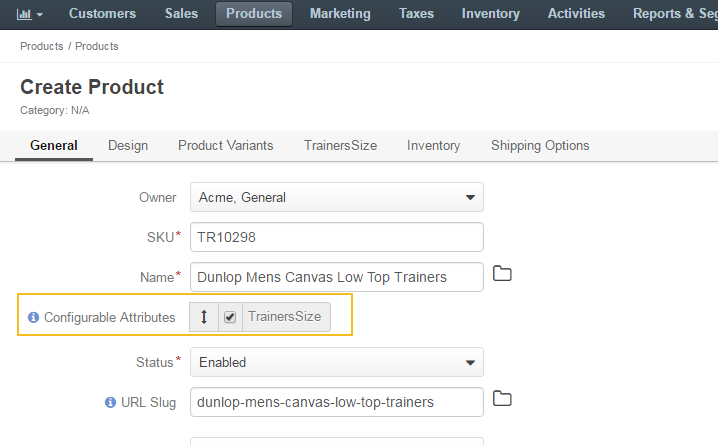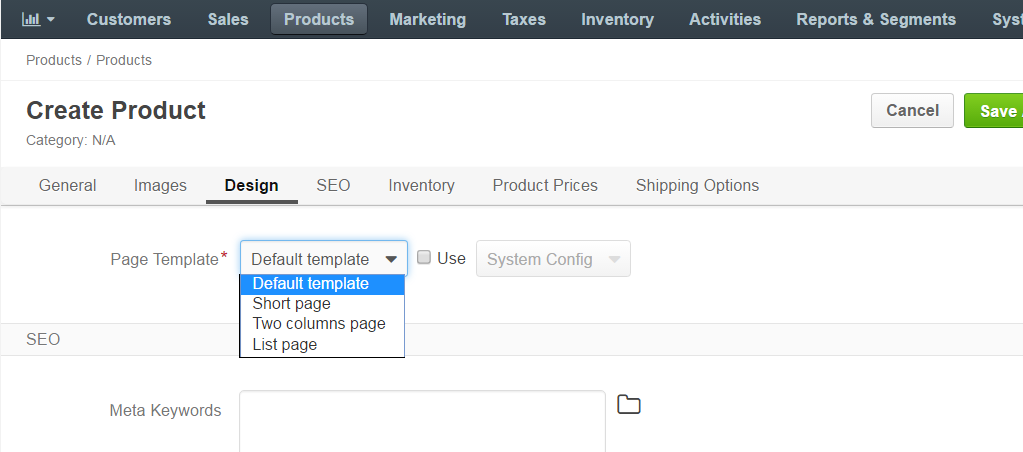Important
You are browsing the documentation for version 1.6 of OroCommerce, OroCRM and OroPlatform, which is no longer maintained. Read version 5.1 (the latest LTS version) of the Oro documentation to get up-to-date information.
See our Release Process documentation for more information on the currently supported and upcoming releases.
Create a Configurable Product
See a short demo on how to create a configurable product or keep reading the step-by-step guidance below.
Checklist
Prior to creating a configurable product, ensure that you have performed the following steps:
Created attributes.
A configurable attribute is one of the product attributes that are used to distinguish product variants of the same configurable product. There should be at least one configurable attribute specified for the configurable product in order to enable a customer to select product variants.
Created a product family.
As a configurable product and all of its variants share the same set of attributes, they should share the product family as well.
Created product variants (simple products).
A configurable product may group several simple products or configurable product variants whose information mostly overlaps except for several product attributes. It means that you have to create a simple product for each variant that you need to add to the configurable product.
Note
Make sure the configurable product you are creating has the same product unit as its product variants.
Note
Product variants for configurable products in the storefront are displayed only when either customer users are logged in or guest shopping lists are enabled in the system configuration.
Flow
To add a new configurable product and make it available in the master catalog (for internal product management) and for purchase in the storefront:
Navigate to Products > Products using the main menu.
Click Create Product.
From the Type list, select Configurable to enable product variants.
Select the product family to define the product options and details that will be filled in the following steps.
Note
Ensure that the product attributes that store product variant options are created and included in the product’s product family.
Place the product under the necessary category in the master catalog by clicking on the category. Use the search to filter the list of categories.
Click Continue.
In the General section, provide the following information:
Field Description Owner Limits the list of users who can manage the product. SKU Enter the product SKU number. The field is mandatory. Name Enter the name of the product. The field is mandatory. Configurable Attributes Define the configurable attributes that distinguish product variants by selecting the check boxes next to them.
Note
A configurable product should contain at least one configurable attribute of select or boolean type.

Status Select the product status (e.g., Enabled/Disabled). When disabled, the product is not included in the catalog and is considered to be a draft. The field is mandatory. URL Slug Enter a URL slug that is used to build a human-readable URL for the product page in the storefront. If left blank, the slug will be autogenerated. Is Featured Select whether the product is featured. The field is mandatory. New Arrival Select whether the product is a new arrival. When set to Yes, the product is highlighted in the storefront. The field is mandatory. Description Enter product description. A description is detailed information about the product that shows on the product view. Short Description Enter a short description to be displayed in the catalog listing. Use the WISIWIG editor to format the information. Brand Choose the product brand, if available. Click to select the brand from the full list. Also, specify the value of your configurable attributes and define any other custom attributes if required.
In the Image section, add a new image to the product by clicking +Add Image and uploading the necessary file. You can select whether the image will be shown as main (the image is used in the product details view), listing (the image is shown in the catalog listing), or additional (additional product pictures). All three categories can be selected at the same time. To remove an image, click next to it.
In the SEO section, specify the required attributes:
Field Description Meta Keywords Enter meta keywords for the product. A meta keyword is a specific type of a meta tag that appears in the HTML code of a web page and helps search engines to understand what the topic of the page is. Meta Title Enter a meta title for the product. A meta title is what is seen by search engine users and helps a search engine to index the page. Meta Description Enter a meta description for the product. A meta description summarizes the page content. Search engines show a meta description in search results when the searched phrase is found in the description. And any other custom attributes if defined.
In the Design section, select the page template from the list.

In the Product Variants section, select the configurable product variants by ticking the Is Variant check box next to the product.

Note
Make sure the configurable product has the same product unit as its product variants.
Review translation rules for a product name, URL slug, description, and short description.
To enter a translation manually, click , clear the Use <parent translation> check box next to the required language, and provide your version of the translation.

Click Save to save your configurable product.

